
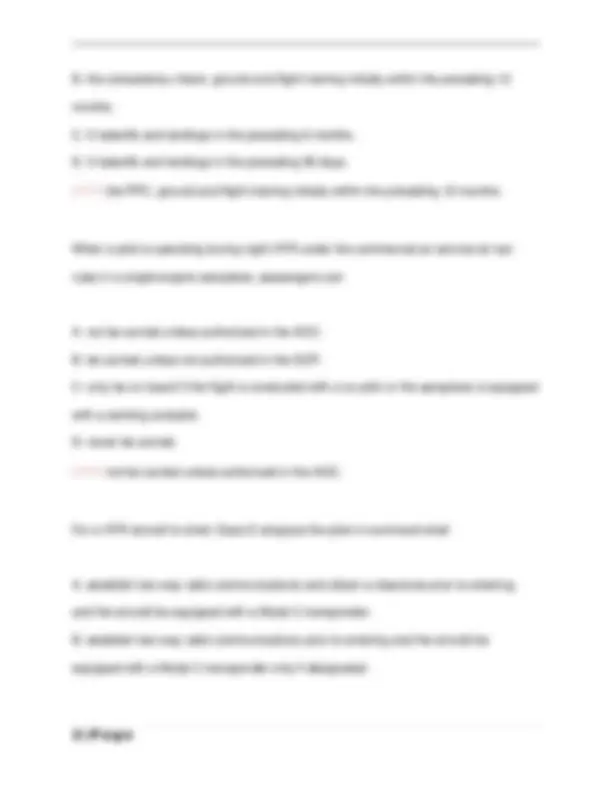
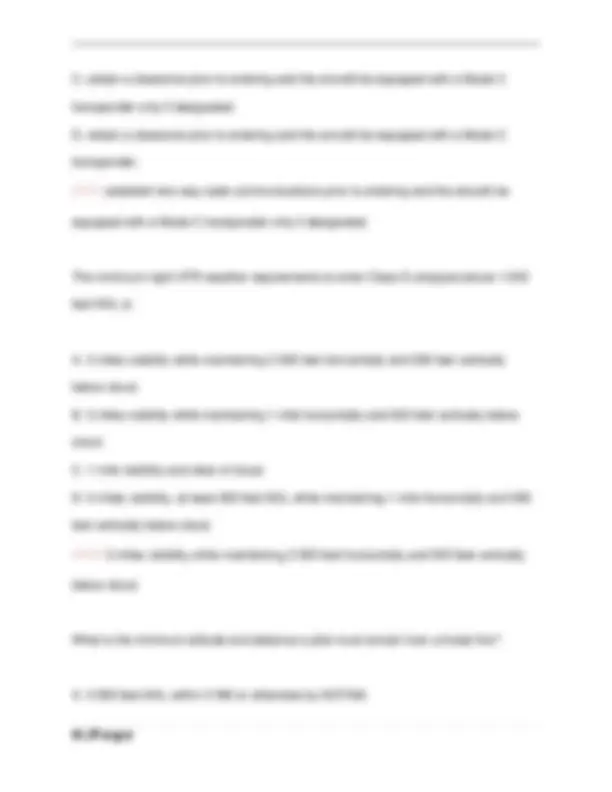
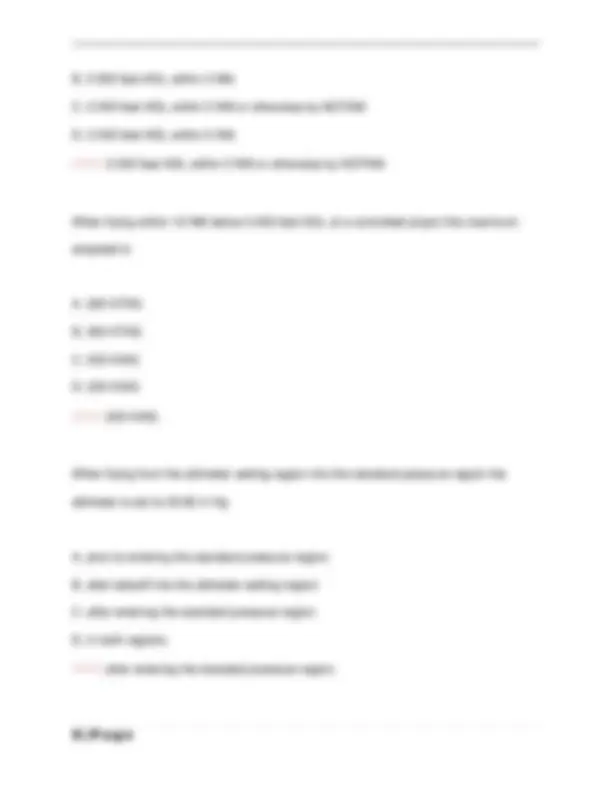
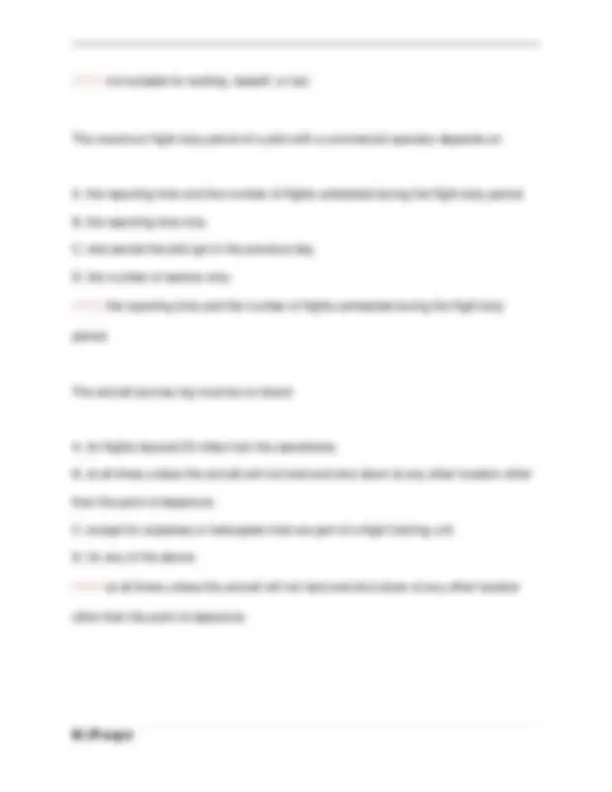
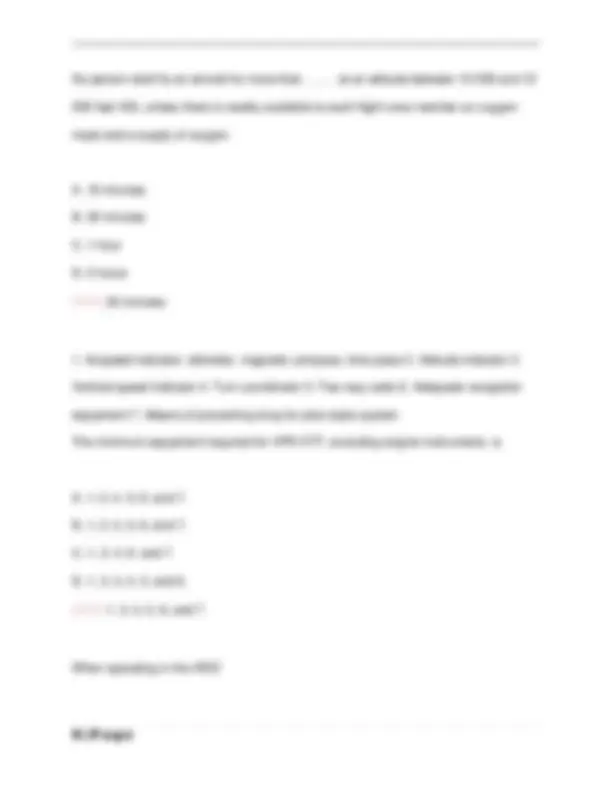
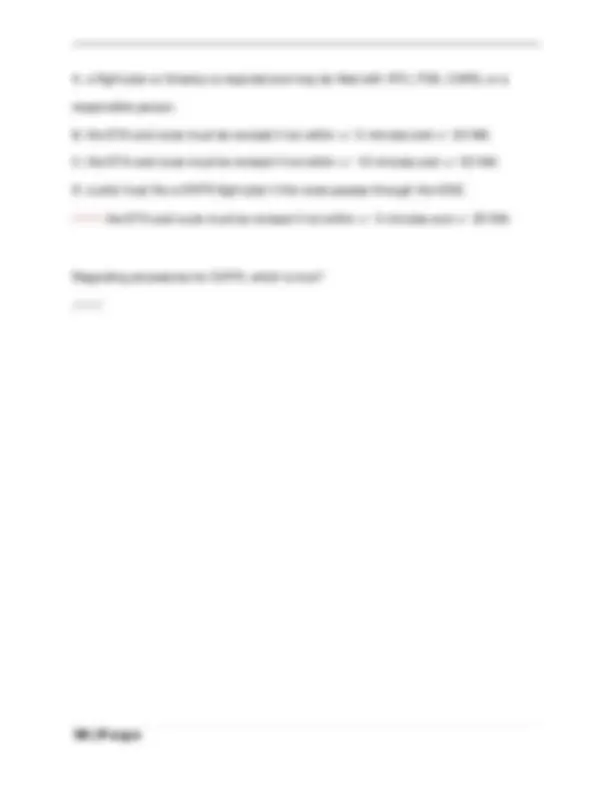


Study with the several resources on Docsity

Earn points by helping other students or get them with a premium plan


Prepare for your exams
Study with the several resources on Docsity

Earn points to download
Earn points by helping other students or get them with a premium plan
Community
Ask the community for help and clear up your study doubts
Discover the best universities in your country according to Docsity users
Free resources
Download our free guides on studying techniques, anxiety management strategies, and thesis advice from Docsity tutors
A set of practice questions and answers for the cpaer exam, covering various aspects of aviation regulations and procedures. It includes multiple-choice questions with correct answers marked, offering a valuable resource for pilots preparing for the exam. The questions cover topics such as pilot qualifications, aircraft operations, weather requirements, and airspace regulations.
Typology: Exams
1 / 10

This page cannot be seen from the preview
Don't miss anything!







In order to act as pilot-in-command of a two-crew aircraft the pilot must have A. a CPL with a checkout for the aircraft. B. an ATPL with a type rating for the aircraft. C. 50 hours on type. D. the IATRA written with 750 hours and a type rating. 🗸🗸🗸: an ATPL with a type rating for the aircraft. A commercial pilot operating an aircraft under the air taxi rules must have completed...
.. takeoffs and landings within the preceding..... days. A. 5, 180 B. 5, 90 C. 3, 60 D. 3, 90 🗸🗸🗸: 3 , 90
A commercial pilot age 30 completed a CAT 1 medical exam on February 13, 2001 and the medical was issued on March 21, 2001. When is the last day this pilot can rent an aircraft and take a friend on a local flight? A. Last day of February 2002. B. First day of March 2002. C. First day of March 2006. D. Last day of February 2006. 🗸🗸🗸: Last day of February 2006. In order to act as pilot-in-command of a single-engine aircraft for an air taxi service under night VFR without passengers a commercial pilot must have A. competency check. B. a valid instrument rating and PPC. C. a valid night rating and competency check. D. none of the above. 🗸🗸🗸: competency check. To act as the pilot-in-command of a multi-engine aeroplane under IMC for an air taxi service, the pilot must have completed A. the PPC, ground and flight training initially within the preceding 12 months.
C. obtain a clearance prior to entering and the aircraft be equipped with a Mode C transponder only if designated. D. obtain a clearance prior to entering and the aircraft be equipped with a Mode C transponder. 🗸🗸🗸: establish two-way radio communications prior to entering and the aircraft be equipped with a Mode C transponder only if designated. The minimum night VFR weather requirements to enter Class G airspace above 1 000 feet AGL is A. 3 miles visibility while maintaining 2 000 feet horizontally and 500 feet vertically below cloud. B. 3 miles visibility while maintaining 1 mile horizontally and 500 feet vertically below cloud. C. 1 mile visibility and clear of cloud. D. 3 miles visibility, at least 500 feet AGL while maintaining 1 mile horizontally and 500 feet vertically below cloud. 🗸🗸🗸: 3 miles visibility while maintaining 2 000 feet horizontally and 500 feet vertically below cloud. What is the minimum altitude and distance a pilot must remain from a forest fire? A. 5 000 feet AGL within 3 NM or otherwise by NOTAM.
B. 5 000 feet AGL within 3 NM. C. 3 000 feet AGL within 5 NM or otherwise by NOTAM. D. 3 000 feet AGL within 5 NM. 🗸🗸🗸: 3 000 feet AGL within 5 NM or otherwise by NOTAM. When flying within 10 NM below 3 000 feet AGL of a controlled airport the maximum airspeed is A. 200 KTAS. B. 250 KTAS. C. 200 KIAS. D. 250 KIAS. 🗸🗸🗸: 200 KIAS. When flying from the altimeter setting region into the standard pressure region the altimeter is set to 29.92 in Hg A. prior to entering the standard pressure region. B. after takeoff into the altimeter setting region. C. after entering the standard pressure region. D. in both regions. 🗸🗸🗸: after entering the standard pressure region.
A. applies to aircraft having a maximum takeoff weight greater than 2 250 kg (5 000 lb). B. applies to all aircraft. C. only applies to aircraft operated in commercial air services. D. only applies to aircraft having a maximum takeoff weight less than 5 700 kg. 🗸🗸🗸: applies to aircraft having a maximum takeoff weight greater than 2 250 kg (5 000 lb). When operating under commercial air service rules A. aerial application is not allowed at night unless authorized in AOC. B. an aerial work operator shall not operate a single-engine aircraft at night or VFR OTT or in IMC unless authorized in AOC. C. VFR OTT must be specifically authorized in the AOC for an air taxi service. D. all of the above apply. 🗸🗸🗸: all of the above apply. Chevron markings preceding a runway threshold indicates that this surface is A. not suitable for the landing roll-out but may be used for taxi or takeoff. B. not suitable for the initial takeoff but may be used for taxi. C. not suitable for landing, takeoff, or taxi. D. a displaced threshold.
🗸🗸🗸: not suitable for landing, takeoff, or taxi. The maximum flight duty period of a pilot with a commercial operator depends on A. the reporting time and the number of flights scheduled during the flight duty period. B. the reporting time only. C. rest period the pilot got in the previous day. D. the number of sectors only. 🗸🗸🗸: the reporting time and the number of flights scheduled during the flight duty period. The aircraft journey log must be on board A. for flights beyond 25 miles from the aerodrome. B. at all times unless the aircraft will not land and shut down at any other location other than the point of departure. C. except for airplanes or helicopters that are part of a flight training unit. D. for any of the above. 🗸🗸🗸: at all times unless the aircraft will not land and shut down at any other location other than the point of departure.
A. a flight plan or itinerary is required and may be filed with ATC, FSS, CARS, or a responsible person. B. the ETA and route must be revised if not within +/- 5 minutes and +/- 20 NM. C. the ETA and route must be revised if not within +/- 10 minutes and +/- 20 NM. D. a pilot must file a DVFR flight plan if the route passes through the ADIZ. 🗸🗸🗸: the ETA and route must be revised if not within +/- 5 minutes and +/- 20 NM. Regarding procedures for SVFR, which is true? 🗸🗸🗸: